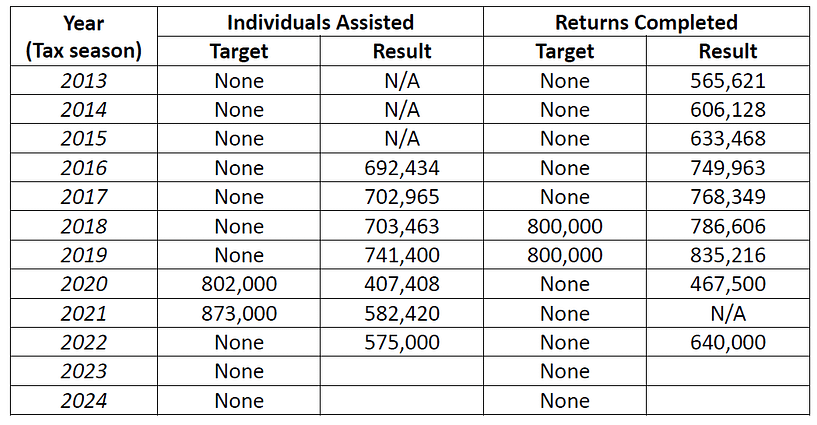April 10, 2023

The CRA’s lack of ambition for the CVITP …
The CRA’s treatment of its key performance indicators or targets for the CVITP illustrate how meaningless the whole exercise is in having departments establish, deliver and report on results.
The CRA set its own targets for the CVITP (using “returns completed”) and then, two years later, changed the nature of what it was measuring (to “individuals assisted”). Then, when the results for individuals assisted fell dramatically short of the targets for the next two years, the CRA dropped any further reference to the CVITP in its key performance indicators.
It is difficult to imagine how the CRA could have made effective use of two years of performance information against either target to significantly manage and improve the CVITP. Instead of using the targets and subsequent performance as management tools, it is not difficult to imagine that the targets were primarily communication tools used to publicly signal the CRA’s rising aspirations for the CVITP.
Key performance indicators are supposed to form part of a Departmental Results Framework. These indicators are supposed to reflect the key responsibilities of the department. (The CRA has two main programs: tax and benefits. As we have previously mentioned, oddly enough the CRA counted the CVITP target as a performance indicator for its tax rather than its benefit program before dropping it entirely.)
The elimination of any further performance indicator for the CVITP suggests the CRA no longer considers that the CVITP reflects part of its key responsibilities.
… in response to notably poor CVITP results …
Budget 2018 confirmed a quadrupling of the CRA’s budget for the CVITP. This was in line with the CRA’s high ambitions for the CVITP at that time. As we have shown, the CVITP’s results fell considerably short of these ambitions.
But it is not just the CRA’s ambitions for the CVITP which have been deflated. The CVITP continues to underperform when compared with its results prior to the COVID pandemic. CRA data for the 2022 tax season, the most recent available, show the number of returns completed and individuals assisted represent about three quarters of the result achieved in the 2019 tax season.
Worse still, the number of returns completed is only a 13% increase over the number produced for the 2013 tax season (the earliest figure reported by the CRA). And the number of individuals assisted is only about 80% of the number for the 2016 tax season (the earliest figure reported by the CRA).
Yet, over the same period, the federal government has increasingly used the return process as its principal tool for allocating a growing number of income-tested benefits. (Most recently, these have included the Canada Dental Benefit, the one-time top up to the Canada Housing Benefit and the “grocery rebate” announced in Budget 2023.)
It is unclear how, despite a quadrupling of its CVITP budget, the CRA has managed to produce such poor results.
In recent times, the CRA no longer has, at least on the public record, any ambitions for the CVITP other than to see it grow “organically” as it did prior to the 2018 tax season. It seems to be counting on its pilot grant program to facilitate this growth.
However, the implementation period for the pilot grant program (2021-2023) coincides with the three tax seasons which immediately follow the 2020 tax season when public health related restrictions were first introduced. As normalcy has returned to public life and the CVITP, we should reasonably expect the CVITP to recover some of the ground it lost in 2020 as more of its host organizations reopen their clinics and their volunteers prepare more returns for clients. We strongly suspect that any CVITP rebound in performance during the 2021-2023 period would have come even in the absence of the pilot grant program.
… raises doubts about the federal government’s commitment toward achieving its poverty reduction goals
The fact that the CRA has quietly abandoned its growth ambitions for the CVITP calls into question the federal government’s statement in its 2018 Poverty Reduction Strategy (PRS) that it sees the CVITP as a key program for helping to deliver on the PRS objectives.
The CRA has never publicly acknowledged that it sees the CVITP as contributing to poverty reduction. (Again, its inclusion of the CVITP under its tax rather than its benefits program suggests the CRA is stuck with an outdated perception of the reason why low-income people seek out CVITP services.)
Employment and Social Development Canada (ESDC) is the lead department for the government’s PRS. However, this means relatively little in practical terms. ESDC manages the National Advisory Council on Poverty. Statistics Canada leads on tracking the data and reporting on all dimensions of poverty in Canada. There does not appear to be much else going on with the PRS itself.
At present, we believe the CRA is not doing enough to ensure that its contribution to the PRS – the CVITP – is effective. If the PRS is genuinely a strategy and not just a communications tool, the federal government needs to follow up and ensure that the relevant departments and agencies it depends on to achieve the PRS objectives are implementing their initiatives effectively. Someone senior inside the federal government needs to be calling the CRA to account for its poor implementation of the CVITP.
